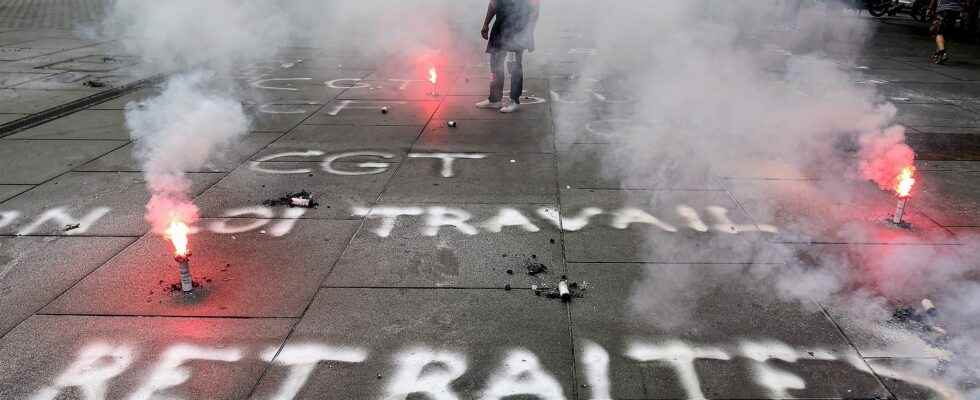The unions are galvanized after the success of the demonstration on Thursday January 19 where between 1.2 and 2 million French people beat the pavement to protest against the pension reform carried out by Emmanuel Macron. This is more than in 2019, when strikes had slowed down the adoption of a point-based retirement system, before the Covid-19 buried the project of the government of Edouard Philippe. Among the workers, the strike was very well attended, paralyzing many sectors: the traffic of the port of Calais, the first in France for travellers, was for example stopped and nearly half of the railway workers followed the movement. .
The strike rates in the refineries of TotalEnergie (between 70 and 100% according to the unions), at EDF (50%), among civil servants (1/3 according to the ministry) are pushing the unions to renew their call for a major mobilization on January 31 to roll back the government. What impact would new strikes have on the country’s economy? For Sylvain Bersinger, economist at Asterès, the cost of such movements is negligible compared to the French annual GDP. The strike would have to last several months and completely paralyze the country for it to have a real impact on French growth.
L’Express: What could be the economic impact of a long and closely followed strike against the pension reform?
Sylvain Bersinger: This is not the first time that there is this kind of movement. Let’s look at what happened in previous strikes against a pension reform: whether in 1995 in 2007 or in 2010, each time, the impact on the economy (therefore on GDP, growth) is very weak. In concrete terms, GDP was impacted by 0.1 or 0.2 points. There, we are talking about social movements that lasted several days or even several weeks, not a day.
Moreover, this relatively small impact is generally made up for in the following quarter. For example, people who had planned to travel but couldn’t because there was no train, do so a little later. So on annual growth, the impact is almost non-existent.
Another more recent example: in the refineries in the fall of 2022, there was a very sharp drop in production (up to 50% in September-October). However, from November, production rebounded and roughly returned to its pre-strike level. Obviously, there is a momentary impact when you close a factory, but over a year and on a trend growth dynamic, that does not fundamentally change things.
Do we know how much a very popular strike day costs?
It’s hard to say. It all depends on the scope of the strike and the sectors affected. The daily peak of France’s GDP is around just over 6 billion euros. The calculation: 2400 billion euros (the annual GDP of France) divided by 365 (number of days in the year). Let’s say that if 15 to 25% of activity in France is paralyzed by the strike, we can arrive at 1.5 billion in costs over one day. But to reach such a figure, the strike would have to be particularly important and followed by many sectors such as the RATP, truck drivers, factories, etc.
It is very difficult to estimate the loss of activity for the sectors on strike and their users, especially when we know that a good part will be caught up in the following days. Last week’s strike mainly involved SNCF and RATP, with a few refineries as well. In my opinion, the cost over the day amounts to several hundred million euros. On an annual GDP of 2400 billion euros, that does not represent much.
It therefore makes no sense to equate the cost of a day’s strike with that of the pension plan deficit.
No, that doesn’t make sense. Let us compare with May 68 where the demonstration was particularly important and lasted one month. The strike paralyzed the economy, the factories were blocked, there was no more gasoline. The GDP collapsed, it fell by about 5% in the second quarter of 1968, but it rebounded very strongly in the following quarter. Finally, the annual growth of 1968 was 5%, as for the other years of the “Trente Glorieuses”. Catch-up effects are very important, people tend to forget that. The cost of a day’s strike therefore does not mean much.
Not to mention that teleworking has become widespread in recent years…
Absolutely. However, the figures are lacking on this subject. We have not yet experienced a post-Covid and post-generalization of telework strike, but it is certain that the RATP strikes have much less impact today because telework has developed enormously in many sectors. . The cost of strikes in transport has fallen but we cannot yet measure the extent.
How long must a strike last for it to have a significant impact on French GDP?
It would really take strikes lasting several months, both strong and long enough to harm the productive capacity of the economy. Concretely, when the factories reopen, the equipment would have to be rusty, the employees would have lost their skills, etc. Even in May 68, which was the biggest strike in the country’s history, we didn’t see that. Afterwards, there is also a reputational cost which is hard to estimate: if foreign investors think that France is a country of lazy people… But there is no data on the subject to my knowledge. It is possible that this cost is more symbolic than anything else.
